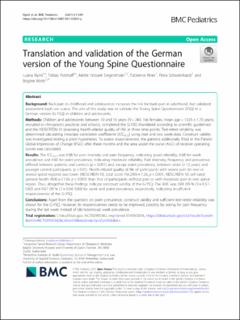Please use this identifier to cite or link to this item:
https://doi.org/10.21256/zhaw-23149Full metadata record
| DC Field | Value | Language |
|---|---|---|
| dc.contributor.author | Nyirö, Luana | - |
| dc.contributor.author | Potthoff, Tobias | - |
| dc.contributor.author | Siegenthaler, Mette Hobaek | - |
| dc.contributor.author | Riner, Fabienne | - |
| dc.contributor.author | Schweinhardt, Petra | - |
| dc.contributor.author | Wirth, Brigitte | - |
| dc.date.accessioned | 2021-09-18T13:06:08Z | - |
| dc.date.available | 2021-09-18T13:06:08Z | - |
| dc.date.issued | 2021-08-24 | - |
| dc.identifier.issn | 1471-2431 | de_CH |
| dc.identifier.uri | https://digitalcollection.zhaw.ch/handle/11475/23149 | - |
| dc.description.abstract | Background Back pain in childhood and adolescence increases the risk for back pain in adulthood, but validated assessment tools are scarce. The aim of this study was to validate the Young Spine Questionnaire (YSQ) in a German version (G-YSQ) in children and adolescents. Methods Children and adolescents between 10 and 16 years (N?=?240, 166 females, mean age?=?13.05?±?1.70 years), recruited in chiropractic practices and schools, completed the G-YSQ (translated according to scientific guidelines) and the KIDSCREEN-10 (assessing health-related quality of life) at three time points. Test-retest reliability was determined calculating intraclass correlation coefficients [ICC(3,1)] using start and two week-data. Construct validity was investigated testing a priori hypotheses. To assess responsiveness, the patients additionally filled in the Patient Global Impression of Change (PGIC) after three months and the area under the curve (AUC) of receiver operating curves was calculated. Results The ICC(3,1) was 0.88 for pain intensity and pain frequency, indicating good reliability, 0.68 for week prevalence and 0.60 for point prevalence, indicating moderate reliability. Pain intensity, frequency and prevalence differed between patients and controls (p?<?0.001) and, except point prevalence, between older (>?12 years) and younger control participants (p?<?0.01). Health-related quality of life of participants with severe pain (in one or several spinal regions) was lower (KIDSCREEN-10, total score: F(4,230)?=?7.26, p?<?0.001; KIDSCREEN-10, self-rated general health: H(4)?=?51.94, p?<?0.001) than that of participants without pain or with moderate pain in one spinal region. Thus, altogether these findings indicate construct validity of the G-YSQ. The AUC was 0.69 (95?% CI?=?0.57–0.82) and 0.67 (95?% CI?=?0.54–0.80) for week and point prevalence, respectively, indicating insufficient responsiveness of the G-YSQ. Conclusions Apart from the question on point prevalence, construct validity and sufficient test-retest reliability was shown for the G-YSQ. However, its responsiveness needs to be improved, possibly by asking for pain frequency during the last week instead of (dichotomous) week prevalence. | de_CH |
| dc.language.iso | en | de_CH |
| dc.publisher | BioMed Central | de_CH |
| dc.relation.ispartof | BMC Pediatrics | de_CH |
| dc.rights | https://creativecommons.org/licenses/by/4.0/ | de_CH |
| dc.subject | Adolescence | de_CH |
| dc.subject | Back pain | de_CH |
| dc.subject | Childhood | de_CH |
| dc.subject | Neck pain | de_CH |
| dc.subject | Reliability | de_CH |
| dc.subject | Responsiveness | de_CH |
| dc.subject | Validity | de_CH |
| dc.subject | Young Spine Questionnaire | de_CH |
| dc.subject.ddc | 617.5: Orthopädische Chirurgie | de_CH |
| dc.subject.ddc | 618.92: Pädiatrie | de_CH |
| dc.title | Translation and validation of the German version of the Young Spine Questionnaire | de_CH |
| dc.type | Beitrag in wissenschaftlicher Zeitschrift | de_CH |
| dcterms.type | Text | de_CH |
| zhaw.departement | School of Management and Law | de_CH |
| zhaw.organisationalunit | Winterthurer Institut für Gesundheitsökonomie (WIG) | de_CH |
| dc.identifier.doi | 10.1186/s12887-021-02804-y | de_CH |
| dc.identifier.doi | 10.21256/zhaw-23149 | - |
| zhaw.funding.eu | No | de_CH |
| zhaw.issue | 359 | de_CH |
| zhaw.originated.zhaw | Yes | de_CH |
| zhaw.publication.status | publishedVersion | de_CH |
| zhaw.volume | 21 | de_CH |
| zhaw.publication.review | Peer review (Publikation) | de_CH |
| zhaw.author.additional | No | de_CH |
| zhaw.display.portrait | Yes | de_CH |
| Appears in collections: | Publikationen School of Management and Law | |
Files in This Item:
| File | Description | Size | Format | |
|---|---|---|---|---|
| 2021_Nyiroe-etal_German-translation-Young-Spin-Questionnaire.pdf | 1.13 MB | Adobe PDF |  View/Open |
Show simple item record
Nyirö, L., Potthoff, T., Siegenthaler, M. H., Riner, F., Schweinhardt, P., & Wirth, B. (2021). Translation and validation of the German version of the Young Spine Questionnaire. BMC Pediatrics, 21(359). https://doi.org/10.1186/s12887-021-02804-y
Nyirö, L. et al. (2021) ‘Translation and validation of the German version of the Young Spine Questionnaire’, BMC Pediatrics, 21(359). Available at: https://doi.org/10.1186/s12887-021-02804-y.
L. Nyirö, T. Potthoff, M. H. Siegenthaler, F. Riner, P. Schweinhardt, and B. Wirth, “Translation and validation of the German version of the Young Spine Questionnaire,” BMC Pediatrics, vol. 21, no. 359, Aug. 2021, doi: 10.1186/s12887-021-02804-y.
NYIRÖ, Luana, Tobias POTTHOFF, Mette Hobaek SIEGENTHALER, Fabienne RINER, Petra SCHWEINHARDT und Brigitte WIRTH, 2021. Translation and validation of the German version of the Young Spine Questionnaire. BMC Pediatrics. 24 August 2021. Bd. 21, Nr. 359. DOI 10.1186/s12887-021-02804-y
Nyirö, Luana, Tobias Potthoff, Mette Hobaek Siegenthaler, Fabienne Riner, Petra Schweinhardt, and Brigitte Wirth. 2021. “Translation and Validation of the German Version of the Young Spine Questionnaire.” BMC Pediatrics 21 (359). https://doi.org/10.1186/s12887-021-02804-y.
Nyirö, Luana, et al. “Translation and Validation of the German Version of the Young Spine Questionnaire.” BMC Pediatrics, vol. 21, no. 359, Aug. 2021, https://doi.org/10.1186/s12887-021-02804-y.
Items in DSpace are protected by copyright, with all rights reserved, unless otherwise indicated.